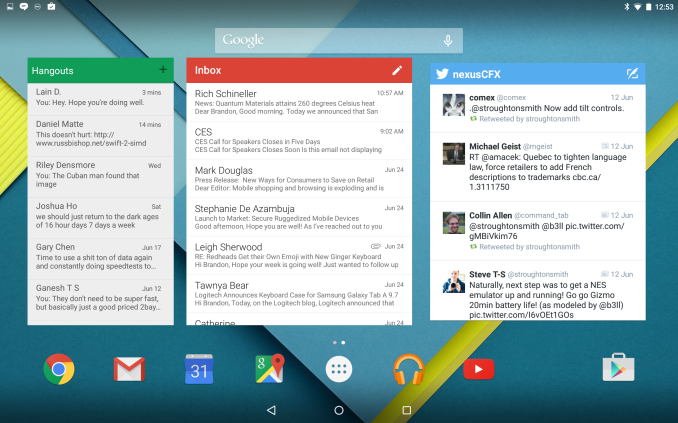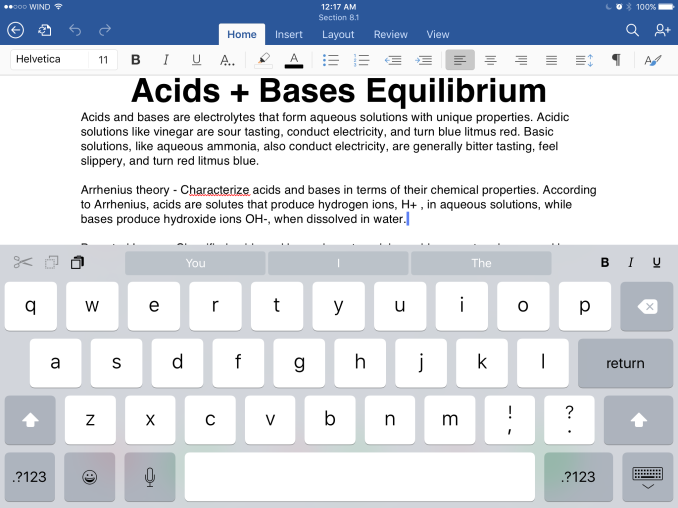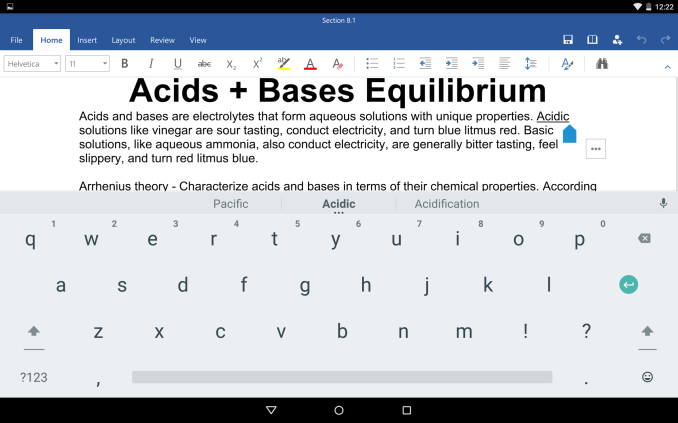The Dell Venue 10 7040 Review
by Brandon Chester on June 30, 2015 8:00 AM ESTSoftware
Dell's Venue 8 came with a mostly unaltered version of Android. It wasn't quite as "stock" as the firmware on Motorola's smartphones, but it was probably the closest you'd get to Google's take on Android without buying a Nexus device. The main changes were a blue background in the app drawer and the Settings app, and some pre-installed applications. With Lollipop on the Venue 10, Dell has moved even closer to a stock Google Android experience.
Like the Dell Venue 8, you're presented with a list of apps that you can install when setting up the tablet. I am totally supportive of OEMs doing this instead of just forcing them upon the user and making them non-removable. The list has grown from nine on the Venue 8 to thirteen on the Venue 10, with the new additions being Skype, the Amazon App Store, Movies by Flixter, and Pinterest. They do come pre-selected, which could prove annoying if a user skips through the install process quickly. Dell does provide a deselect all button though, so it doesn't feel malicious. I ended up using this to install Flipboard, Twitter, and Skype, and I think it would be great if Android OEMs moved toward this method of offering users sponsored apps.
While Dell does optionally offer some apps, they're not completely innocent of including bloatware. The MaxxAudio equalizer and McAfee Security apps come pre-installed, along with Skitch, Evernote, and POLARIS Office 5. You can disable these applications, but you can't remove them.
As far as the rest of the software experience goes, it's almost completely unmodified. While it has a different name and doesn't get updated from Google Play, the launcher is basically the Google Now Launcher. The reason Dell has modified the launcher is because the standard Google Now Launcher doesn't scale well to 16:10 tablets in landscape, as it only has 6 columns for icons. The Settings application has also been replaced with the standard Android version, with no custom background in sight. Dell still manages to include some of their own applications though, including a Dell Live Wallpapers app which I didn't use very often because it adversely affected performance, a Dell Cast app for use with their wireless display dongle, and the My Dell app for viewing stats about your tablet and doing performance checkups. By necessity, there are also special camera and gallery apps to take, view, and edit RealSense photos.
I've already discussed the tablet app situation on Android in depth at this point, but the basic gist is that there are a lot of iPad apps that either don't exist at all, or exist with only a phone UI. The only really great tablet apps that I have on the Venue 10 are Flipboard and Google's Gmail app. The app problem is more pronounced on larger 16:10 Android tablets than smaller ones, because the orientation you tend to default to is landscape rather than portrait. Many apps just give you a horizontally stretched version of what a phone app looks like, and it often looks rather comical. Some apps also force a portrait view mode because they're designed entirely with phones in mind, which is a huge annoyance when using the tablet in the keyboard dock.
I think the 16:10 aspect ratio is a big part of the problems that large Android tablets have faced. While it's a better aspect ratio than 3:2 or 4:3 for watching movies, it's not really good at anything else. 4:3 is very close to the aspect ratio of paper, which makes it well suited to reading books and documents. Many websites don't take advantage of widescreen displays very well either. As far as interface design goes, the extreme difference in proportions with 16:10 tablets means that it's difficult to make apps that naturally expand their interfaces as the tablet is rotated from portrait to landscape. It also forces concessions like heavily rectangular keyboard keys which are more difficult to hit, and in landscape mode not being able to view near as much on the screen. A great example of this can be seen in the Microsoft Word app. Even though the Venue 10 has rectangular keys which are more difficult to hit due to their shortened height, it still shows fewer lines of text than can be seen on the iPad. Microsoft even implemented an Android-specific feature to hide the control bar at the top to deal with the more limited space.
Google and HTC have moved to 4:3 with the Nexus 9, and ASUS has done so with their flagship ZenPad tablet. Samsung's new Galaxy A series tablets are also 4:3, and they're rumored to be making a flagship 4:3 tablet as well. Microsoft hasn't gone quite as far, but their 3:2 Surface 3 and Surface Pro 3 tablets have more balanced proportions than their previous models. I think at this point the industry come to the realization that the 16:10 form factor isn't optimal for tablets, and Dell didn't move to where the puck was going.
UI Performance
During my review of the Venue 8, I noted that performance in benchmarks reflected the raw speed of the device rather than its smoothness or fluidity. Some devices that do amazingly well in benchmarks can still have issues with keeping a steady frame rate, and exhibit the "jank" that Google has tried to reduce with each version of Android. The Dell Venue 8 had a number of issues with keeping the frame rate at 60fps, with a combination of random issues and consistent ones. At the time, I attributed some of these problems to the fact that the Venue 8 was running Android KitKat and could not take advantage of ART or the various performance improvements built into Android Lollipop.
Unfortunately, the Dell Venue 10 still has significant performance issues despite running Google's Android Lollipop. Some of them always occur, while others happen at complete random. In the former case, it's always a low frame rate with an animation. Some apps always stutter during the opening animation, some always stutter when opening the navigation their drawer, and some stutter with every single animation. While some of these problems are ones that I've seen on every Android device, many are not. Above you can see one such issue, with the closing animation for the app drawer. The top clip is a recording of this animation on a Nexus 9, while the bottom is on the Venue 10. When watching both videos at 60fps, it's immediately apparent that the animation drops frames on the Venue 10, and it's very bothersome when one is used to the animation being smooth on other devices.
The latter case is where a performance issue is intermittent and doesn't seem to have any trigger. This has proved to be somewhat frustrating for me, as I haven't been able to find any correlation between the performance issues and heavy RAM, CPU, or GPU usage. While they are random, they are still very frequent, and it's enough to make using the Venue 10 a very unpleasant experience if you're sensitive to changes in frame rate. Above is an example of how the performance in the notification drawer can vary significantly with no apparent change in the state of the tablet. The top video shows it running very smoothly on the Venue 10, while the bottom video shows it running not just below 60fps, but below 30fps. Again, be sure to watch the videos at 60fps to see the problem clearly.
It's very concerning that the Venue 10 exhibits so many performance issues that don't exist on cheaper tablets like the $299 SHIELD Tablet or the $399 Nexus 9. At $499, Dell is competing with the most expensive tablets on the market. The most obvious competitor is the iPad Air 2, a device where you really need to try hard to find anywhere that ever drops below 60fps. If you're not really bothered by the low frame rates then the Venue 10 will work fine for you. But if you are – and I think many people are once animations get into the sub-30fps range – then you won't feel like your $499 tablet offers the premium performance that its premium price should provide.














49 Comments
View All Comments
tsk2k - Tuesday, June 30, 2015 - link
When is the Carrizo review coming out?DigitalFreak - Tuesday, June 30, 2015 - link
I'll save you 8 pages of reading.It sucks.
Hulk - Wednesday, July 1, 2015 - link
Thanks you just saved me 15 minutes. And I'm being totally serious.kyuu - Thursday, July 2, 2015 - link
Can you and the other members of the AMD-hate circle jerk kindly stop infesting the comment section here? Anandtech is a site for people who want to read about tech, not indulge in mindless dickery. Thanks.maglito - Monday, July 6, 2015 - link
Probably when you can actually get a carrizo powered laptop / 2in1. Have you seen any for sale yet? I haven't, and I've been looking. I really want a laptop with 18Gbps HDMI (2.0) and hardware H.265 decode. They were supposed to be available by now....nightbringer57 - Tuesday, June 30, 2015 - link
About the 2 in 1 aspect...I feel the problem of this market niche is the harsh competition from windows 8.1 (soon to be 10) "Tabletbooks" (2 - 1 tablet + netbook devices like the asus T100). Those are really common and you can get very good models around 200-300€. You can really put the keyboard to full use with the (almost) full-fledged Windows compatibility. If you're gonna buy a not-so-good tablet just because it can make an awesome netbook when you need it, those models kick in and ass.
JeremyInNZ - Tuesday, June 30, 2015 - link
The Sony Z4 tablet is arguably the best 10" Android tablet on the market. It also comes with a keyboard doc, and does a much better job then the Dell with it. Just because Dell did a poor job of implementing the idea, does not make it a bad idea.zimanodenea - Tuesday, June 30, 2015 - link
Intel + PowerVR. I'd rather eat dog poop than buy into this combination again.lilmoe - Tuesday, June 30, 2015 - link
What were you expecting? We all know that last generation ATOM's iGPUs suck (and the current x7 sucks a little less). Wait for a $499 Core M tablet if you want something "interesting", and make sure it doesn't go above 1080p if you want 10+ hours of battery life...Samus - Wednesday, July 1, 2015 - link
The elephant in the room here is that this is a $500 Android tablet. $500. Starting price. If it were running Windows this would be a legitimate competitor to the Surface 3.The reality is you can buy two really decent Android tablets for the same price as this, specifically the Asus Transformer. This is basically a $200 Nextbook Ares (includes keyboard) for triple the price. I don't know what Dell is doing here. Covering something in Aluminum doesn't triple its value.